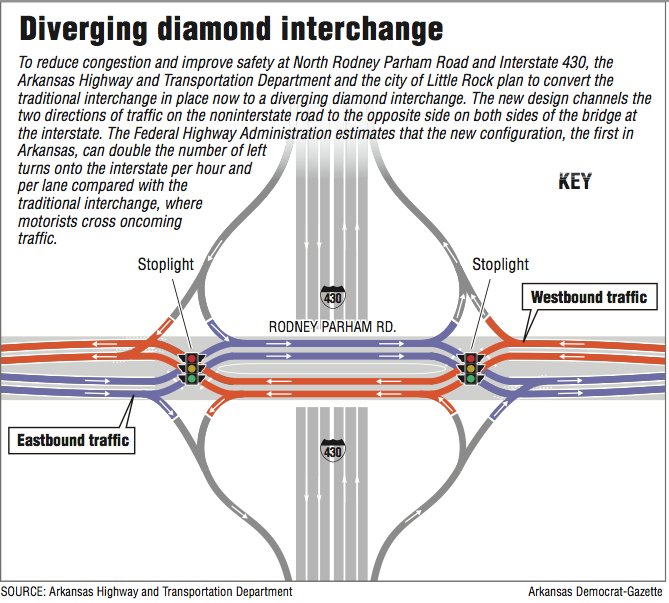At first blush, the proposed solution for traffic congestion at the Interstate 430/North Rodney Parham Road interchange in Little Rock seems as vexing as the problem.
The Arkansas Highway and Transportation Department has proposed converting the traditional diamond interchange there into a diverging diamond interchange, in which two directions of traffic on Rodney Parham would cross to the opposite sides at the I-430 overpass.
Come again?
In other words, traffic in the right-hand lanes on Rodney Parham would be channeled to the left-hand lanes at traffic lights on both ends of the overpass and traffic on the left-hand lanes would be channeled to the right-hand lanes. This would allow for easier access on and off of I-430 and, highway officials say, would alleviate a major traffic choke point.
About 88,000 vehicles travel that stretch of I-430 every day, and a 2012 Metroplan traffic count showed that between 8,200 and 11,000 use the I-430 ramps to and from Rodney Parham Road -- along which is Breckenridge Village, Colony West and other retail shopping centers. As a result, long traffic lines are common at the interchange.
The unorthodox design may take a leap of faith for motorists, but experts insist that it is a cost-effective solution to move more traffic safely through busy interchanges without spending millions of dollars to build a bigger interchange. It is the first use of that design in Arkansas, but it has proved itself elsewhere.
The first interchange retrofitted to accommodate the diverging diamond design in the United States was in Springfield, Mo., in 2009.
"It takes some getting used to," said Martin Gugel, the traffic engineer for the city of Springfield. "But it works."
The Interstate 44/Missouri 13 interchange had almost daily backups on the interstate before the interchange was retrofitted with the diverging diamond design, he said. Backups still occur, but they are limited.
"We used to have backups during the week with no events going on -- mile-long backups," Gugel said. "The only time we see backups now is when we have events at the fairgrounds."
It has worked so well that the city has since retrofitted three more interchanges with the design and has plans to retrofit a fifth.
"It's a way to get more life out of an existing interchange," Gugel said.
Credit or blame for using the design at the I-430/Rodney Parham interchange goes to Bill Henry, the Little Rock traffic engineer who thought the diverging diamond interchange would work well at that location after seeing the design in action on a trip that took him through Springfield.
"I picked it out because I drive Rodney Parham every day," Henry said, referring to his daily commute between home and work. "It seems like a good fit to address the congestion issues we've been having."
What makes the design effective is it eliminates left turns against traffic, he said.
For the traditional diamond interchange, it takes four green-light changes to move a car through the interchange, Henry said. With a diverging diamond interchange, there are no left turns against oncoming traffic and a four-phase signal becomes a two-phase signal, he said.
Thus, the diverging diamond interchange "becomes a lot more efficient in moving traffic," Henry said.
A Federal Highway Administration review of the design reached a similar conclusion, saying the design "demonstrated overall better performance."
The diverging diamond interchange "had less delays, fewer stops, reduced stop times, and shorter queue lengths compared to the conventional design," according to the review. The newer design also can support twice as many left-turn movements as can the conventional design.
The federal report also concluded that the diverging diamond is safer than the conventional diamond because it has only 14 conflict points -- points in which two or more vehicles approach one another in such a way that they would collide if they don't change direction or speed. The conventional design has 26 conflict points.
"The interchange geometry also has traffic-calming features that reduce speeds while maintaining capacity," the report found. "This is expected to result in fewer and less-severe crashes than in a conventional intersection."
The project is a joint effort between the Highway and Transportation Department and the city. Last week, the Arkansas Highway Commission approved an order allowing the project to go forward after Little Rock said it would designate $750,000 in proceeds from a bond issue for the project.
The preliminary cost for the project is about $2 million, said Randy Ort, a Highway and Transportation Department spokesman.
Scott Bennett, the department director, said the agency's share of the project cost would come from its $1 billion interstate-repair program, which voters approved in November 2011. The program is spread over 75 projects totaling more than 450 miles, but Bennett said he believes some money will be left over for smaller projects, such as the interchange.
Once the department and city finalize their partnering agreement, the department will move forward with surveys, plans and construction, according to the order the commission adopted Wednesday.
"It should go pretty quickly," Henry said, noting that the design doesn't require any additional right of way.
State and city officials have taken other steps to address congestion at the interchange, including adding another left-hand turn lane, but those were interim steps until a permanent solution could be found.
SundayMonday on 06/08/2014

